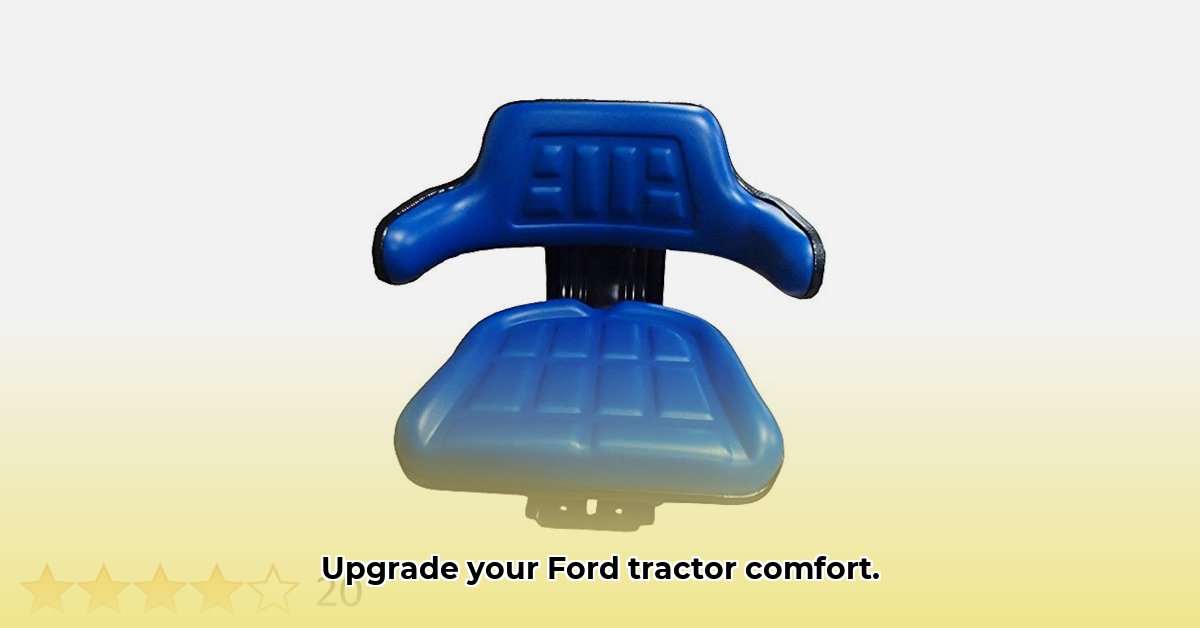
Finding the right tractor seat can transform your workday from back-breaking labor into a comfortable, productive experience. This guide navigates the complexities of Ford tractor seats, helping you find the perfect fit for your model and budget. We'll cover seat types, sourcing options, installation, and maintenance, ensuring you make an informed decision. For guidance on other brands, check out this helpful resource on tractor seat options.
Ford Tractor Seats: Understanding the Options
Ford tractor seats vary widely across models and years, ranging from basic pan seats to advanced suspension models. Choosing the right one depends on factors such as your tractor's model, your budget, and your comfort priorities. Let's examine the key types:
Pan Seats: These are the most basic, affordable option. They're simple, durable, and easy to replace but offer minimal comfort and adjustability. Ideal for occasional use or budget-conscious owners.
Flip-Over Seats: Offering enhanced accessibility, the flip-over design allows you to swing the seat forward for easier access to controls and mounting/dismounting. They generally provide moderate comfort and are a good balance between cost and functionality.
Suspension Seats (e.g., Rest-O-Ride): These high-end seats feature advanced suspension systems to significantly reduce vibration and jarring during operation. They provide superior comfort, especially crucial for extended periods of work. Higher price point.
[Image: A comparison chart showing various seat types with their pros and cons would be inserted here]
Did you know that older Ford models like the 8N often used a standard 19-inch seat width, simplifying the search? Newer models, however, present a more diverse range of sizes and features.
Identifying Your Seat Needs: A Step-by-Step Approach
Before you start shopping, ask yourself these critical questions:
What's my tractor model and year? This is essential for ensuring part compatibility. Incorrect part numbers will cause significant issues.
What features are non-negotiable? Prioritize essential features like suspension or adjustability based on your usage and budget. What materials (vinyl, cloth) are preferable?
What's my budget? OEM parts typically cost more but often offer superior quality and longer warranties. Aftermarket parts provide affordability but may compromise on quality or longevity.
What's the condition of my current seat? A simple repair might be more cost-effective than a complete replacement.
Addressing these points proactively streamlines your search and maximizes your investment.
OEM vs. Aftermarket: A Cost-Benefit Analysis
The choice between Original Equipment Manufacturer (OEM) parts – made by Ford or to their specifications – and aftermarket alternatives significantly impacts cost and quality.
OEM Pros: Guaranteed fit and superior quality, often backed by longer warranties. Higher initial cost, however.
OEM Cons: Can be harder to find and more expensive.
Aftermarket Pros: More affordable, wider variety of styles and features available.
Aftermarket Cons: May require modifications for proper fit, quality can vary, and shorter warranties are common.
The decision hinges on your budget and tolerance for potential compromises in quality and fit. A cost-benefit analysis is crucial.
Sourcing and Purchasing Your Ford Tractor Seat
Finding the optimal seat involves exploring multiple avenues:
Online Retailers: Major online retailers specializing in agricultural equipment (e.g., Tractor Supply Co.) offer a wide selection and detailed information.
Local Suppliers: Farm supply stores and equipment dealers may have seats in stock or can order them for you. This offers the benefit of viewing the seat before purchase and acquiring expert advice.
Restoration Shops: Specializing in classic tractors, these shops are a good source for hard-to-find parts for older models.
Remember to always double-check part numbers to ensure compatibility. Comparing prices across vendors is crucial.
Installation and Maintenance: Ensuring Longevity
Installing a tractor seat can vary in difficulty depending on its design and your tractor model. Consult your tractor's owner manual for detailed instructions or seek professional assistance if needed. Online videos can also be a valuable resource.
Regular maintenance extends the seat's lifespan. Keep it clean and dry, and address minor wear and tear promptly to prevent more significant problems.
Conclusion: The Perfect Seat for Your Needs
Selecting the right Ford tractor seat is a multifaceted process. Understanding seat types, assessing your needs, weighing OEM vs. aftermarket choices, and sourcing the part strategically ensures that your investment results in years of comfortable, productive work. Remember that your comfort has a direct impact on efficiency, making choosing the perfect seat a wise choice.